BAF-6-FOF: Comparative Analysis of Investment Projects in Finance
VerifiedAdded on 2023/06/13
|15
|3558
|112
Report
AI Summary
This report evaluates two investment proposals using investment appraisal techniques, focusing on the appropriate cost of capital and risk factors. It compares extending the production capacity of a current product with launching a new product line, considering NPV, payback period, and IRR. The analysis recommends using the Weighted Average Cost of Capital method and factoring in risks like changes in cost of capital and selling price. Detailed calculations and comparisons are provided to aid in decision-making, with the goal of maximizing value for stakeholders. Desklib offers a wealth of similar solved assignments and past papers to assist students in their studies.

Running head: FINANCE
Finance
Name of the Student:
Name of the University:
Authors Note:
Finance
Name of the Student:
Name of the University:
Authors Note:
Paraphrase This Document
Need a fresh take? Get an instant paraphrase of this document with our AI Paraphraser
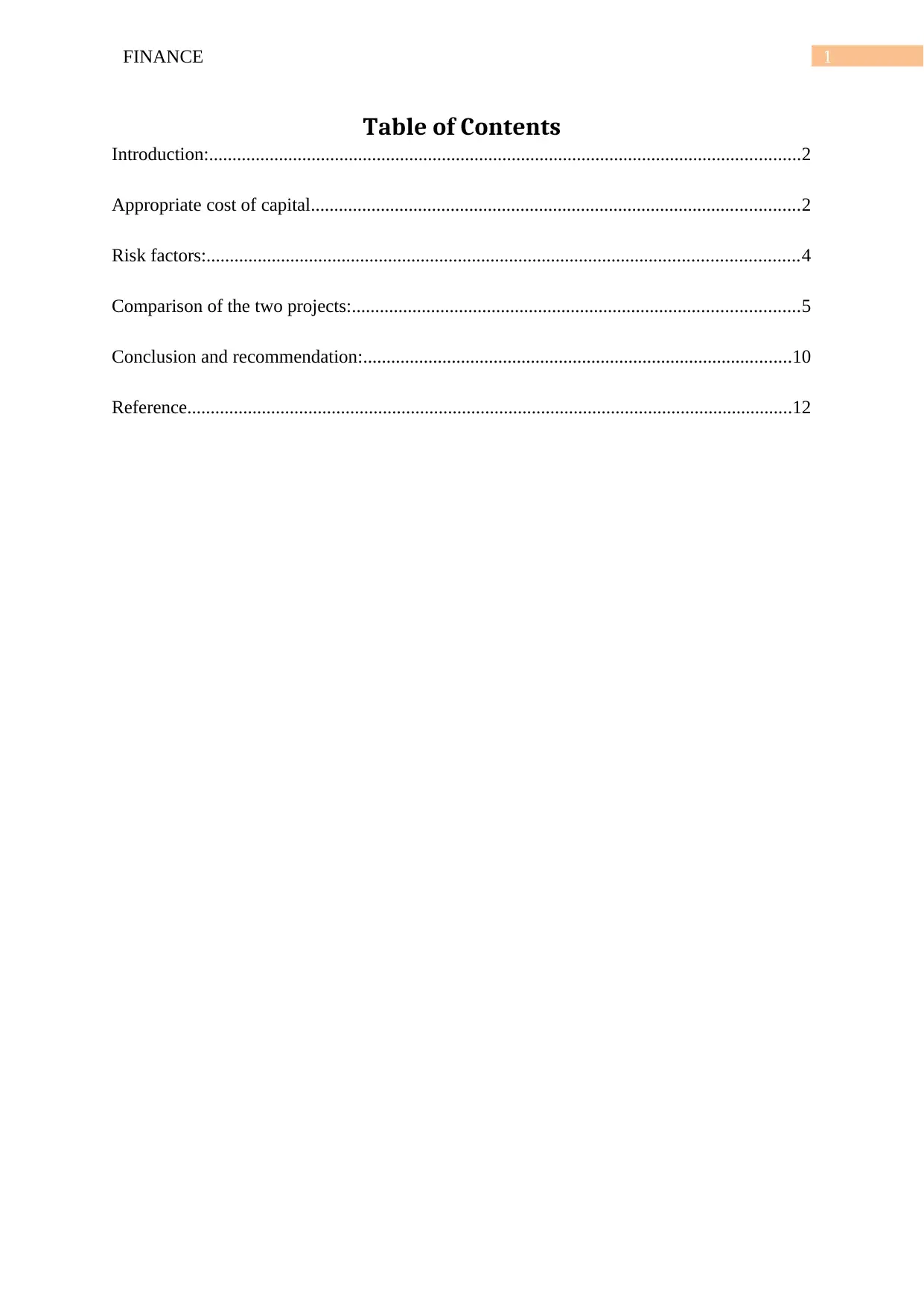
1FINANCE
Table of Contents
Introduction:...............................................................................................................................2
Appropriate cost of capital.........................................................................................................2
Risk factors:...............................................................................................................................4
Comparison of the two projects:................................................................................................5
Conclusion and recommendation:............................................................................................10
Reference..................................................................................................................................12
Table of Contents
Introduction:...............................................................................................................................2
Appropriate cost of capital.........................................................................................................2
Risk factors:...............................................................................................................................4
Comparison of the two projects:................................................................................................5
Conclusion and recommendation:............................................................................................10
Reference..................................................................................................................................12
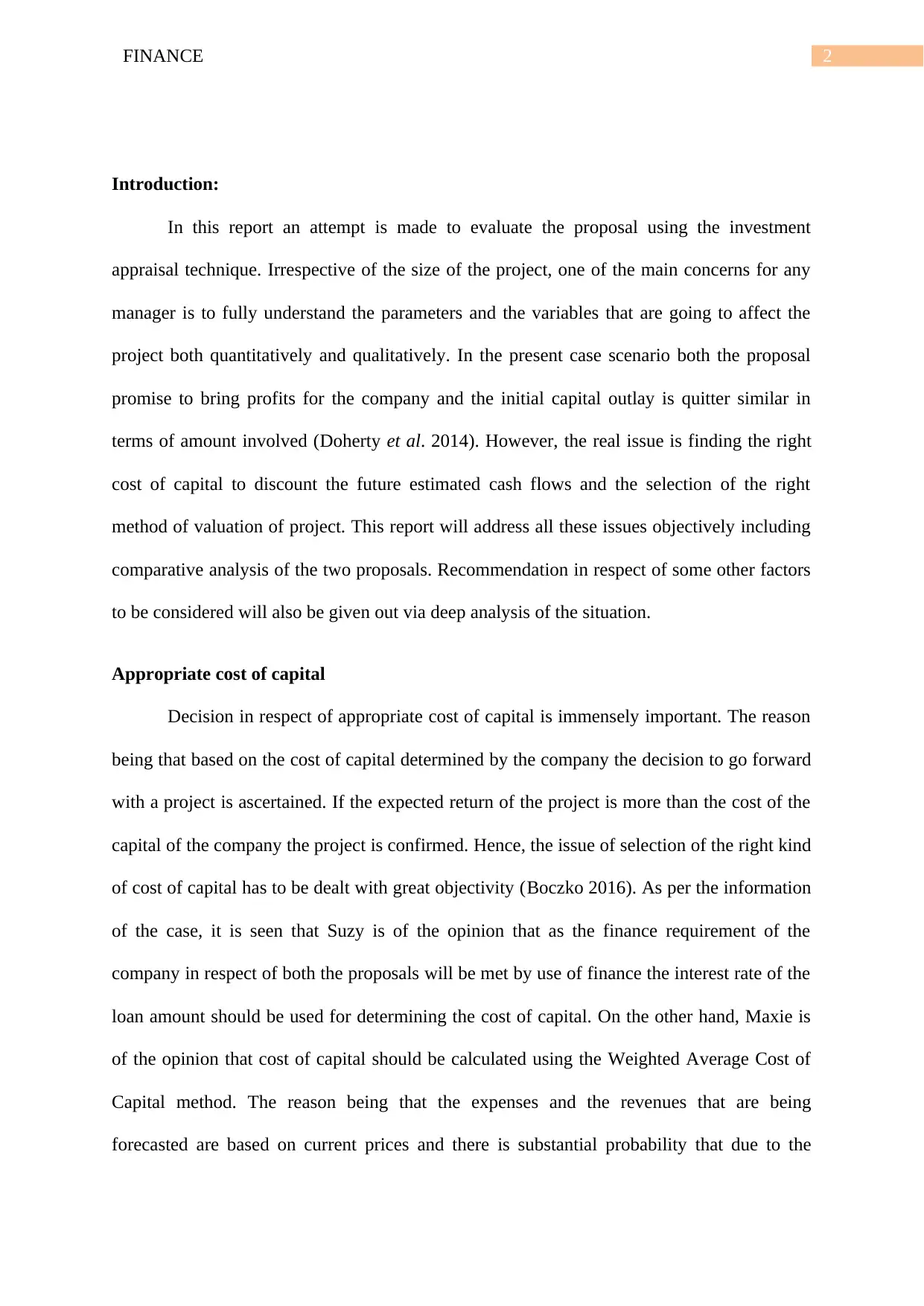
2FINANCE
Introduction:
In this report an attempt is made to evaluate the proposal using the investment
appraisal technique. Irrespective of the size of the project, one of the main concerns for any
manager is to fully understand the parameters and the variables that are going to affect the
project both quantitatively and qualitatively. In the present case scenario both the proposal
promise to bring profits for the company and the initial capital outlay is quitter similar in
terms of amount involved (Doherty et al. 2014). However, the real issue is finding the right
cost of capital to discount the future estimated cash flows and the selection of the right
method of valuation of project. This report will address all these issues objectively including
comparative analysis of the two proposals. Recommendation in respect of some other factors
to be considered will also be given out via deep analysis of the situation.
Appropriate cost of capital
Decision in respect of appropriate cost of capital is immensely important. The reason
being that based on the cost of capital determined by the company the decision to go forward
with a project is ascertained. If the expected return of the project is more than the cost of the
capital of the company the project is confirmed. Hence, the issue of selection of the right kind
of cost of capital has to be dealt with great objectivity (Boczko 2016). As per the information
of the case, it is seen that Suzy is of the opinion that as the finance requirement of the
company in respect of both the proposals will be met by use of finance the interest rate of the
loan amount should be used for determining the cost of capital. On the other hand, Maxie is
of the opinion that cost of capital should be calculated using the Weighted Average Cost of
Capital method. The reason being that the expenses and the revenues that are being
forecasted are based on current prices and there is substantial probability that due to the
Introduction:
In this report an attempt is made to evaluate the proposal using the investment
appraisal technique. Irrespective of the size of the project, one of the main concerns for any
manager is to fully understand the parameters and the variables that are going to affect the
project both quantitatively and qualitatively. In the present case scenario both the proposal
promise to bring profits for the company and the initial capital outlay is quitter similar in
terms of amount involved (Doherty et al. 2014). However, the real issue is finding the right
cost of capital to discount the future estimated cash flows and the selection of the right
method of valuation of project. This report will address all these issues objectively including
comparative analysis of the two proposals. Recommendation in respect of some other factors
to be considered will also be given out via deep analysis of the situation.
Appropriate cost of capital
Decision in respect of appropriate cost of capital is immensely important. The reason
being that based on the cost of capital determined by the company the decision to go forward
with a project is ascertained. If the expected return of the project is more than the cost of the
capital of the company the project is confirmed. Hence, the issue of selection of the right kind
of cost of capital has to be dealt with great objectivity (Boczko 2016). As per the information
of the case, it is seen that Suzy is of the opinion that as the finance requirement of the
company in respect of both the proposals will be met by use of finance the interest rate of the
loan amount should be used for determining the cost of capital. On the other hand, Maxie is
of the opinion that cost of capital should be calculated using the Weighted Average Cost of
Capital method. The reason being that the expenses and the revenues that are being
forecasted are based on current prices and there is substantial probability that due to the
⊘ This is a preview!⊘
Do you want full access?
Subscribe today to unlock all pages.

Trusted by 1+ million students worldwide
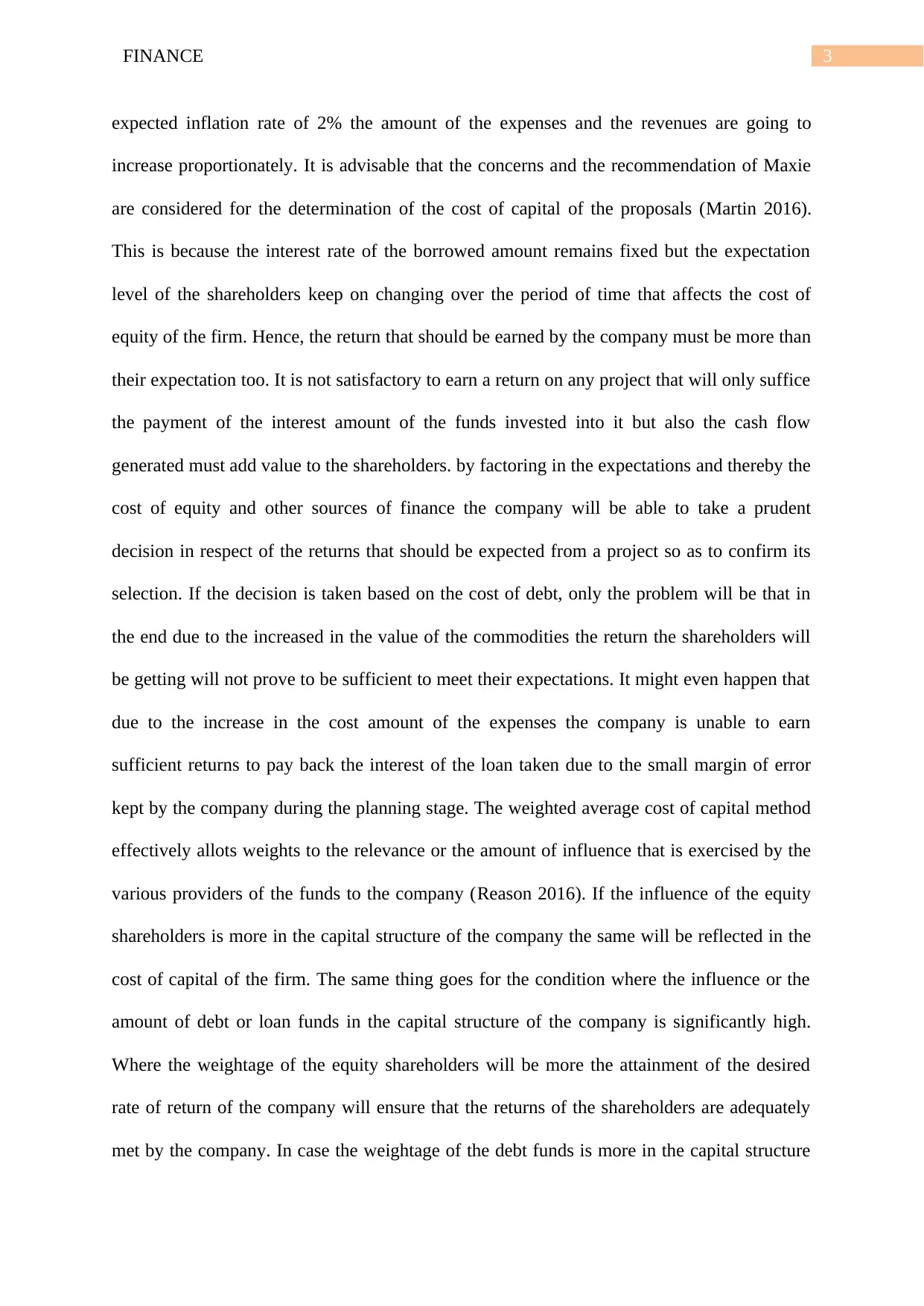
3FINANCE
expected inflation rate of 2% the amount of the expenses and the revenues are going to
increase proportionately. It is advisable that the concerns and the recommendation of Maxie
are considered for the determination of the cost of capital of the proposals (Martin 2016).
This is because the interest rate of the borrowed amount remains fixed but the expectation
level of the shareholders keep on changing over the period of time that affects the cost of
equity of the firm. Hence, the return that should be earned by the company must be more than
their expectation too. It is not satisfactory to earn a return on any project that will only suffice
the payment of the interest amount of the funds invested into it but also the cash flow
generated must add value to the shareholders. by factoring in the expectations and thereby the
cost of equity and other sources of finance the company will be able to take a prudent
decision in respect of the returns that should be expected from a project so as to confirm its
selection. If the decision is taken based on the cost of debt, only the problem will be that in
the end due to the increased in the value of the commodities the return the shareholders will
be getting will not prove to be sufficient to meet their expectations. It might even happen that
due to the increase in the cost amount of the expenses the company is unable to earn
sufficient returns to pay back the interest of the loan taken due to the small margin of error
kept by the company during the planning stage. The weighted average cost of capital method
effectively allots weights to the relevance or the amount of influence that is exercised by the
various providers of the funds to the company (Reason 2016). If the influence of the equity
shareholders is more in the capital structure of the company the same will be reflected in the
cost of capital of the firm. The same thing goes for the condition where the influence or the
amount of debt or loan funds in the capital structure of the company is significantly high.
Where the weightage of the equity shareholders will be more the attainment of the desired
rate of return of the company will ensure that the returns of the shareholders are adequately
met by the company. In case the weightage of the debt funds is more in the capital structure
expected inflation rate of 2% the amount of the expenses and the revenues are going to
increase proportionately. It is advisable that the concerns and the recommendation of Maxie
are considered for the determination of the cost of capital of the proposals (Martin 2016).
This is because the interest rate of the borrowed amount remains fixed but the expectation
level of the shareholders keep on changing over the period of time that affects the cost of
equity of the firm. Hence, the return that should be earned by the company must be more than
their expectation too. It is not satisfactory to earn a return on any project that will only suffice
the payment of the interest amount of the funds invested into it but also the cash flow
generated must add value to the shareholders. by factoring in the expectations and thereby the
cost of equity and other sources of finance the company will be able to take a prudent
decision in respect of the returns that should be expected from a project so as to confirm its
selection. If the decision is taken based on the cost of debt, only the problem will be that in
the end due to the increased in the value of the commodities the return the shareholders will
be getting will not prove to be sufficient to meet their expectations. It might even happen that
due to the increase in the cost amount of the expenses the company is unable to earn
sufficient returns to pay back the interest of the loan taken due to the small margin of error
kept by the company during the planning stage. The weighted average cost of capital method
effectively allots weights to the relevance or the amount of influence that is exercised by the
various providers of the funds to the company (Reason 2016). If the influence of the equity
shareholders is more in the capital structure of the company the same will be reflected in the
cost of capital of the firm. The same thing goes for the condition where the influence or the
amount of debt or loan funds in the capital structure of the company is significantly high.
Where the weightage of the equity shareholders will be more the attainment of the desired
rate of return of the company will ensure that the returns of the shareholders are adequately
met by the company. In case the weightage of the debt funds is more in the capital structure
Paraphrase This Document
Need a fresh take? Get an instant paraphrase of this document with our AI Paraphraser
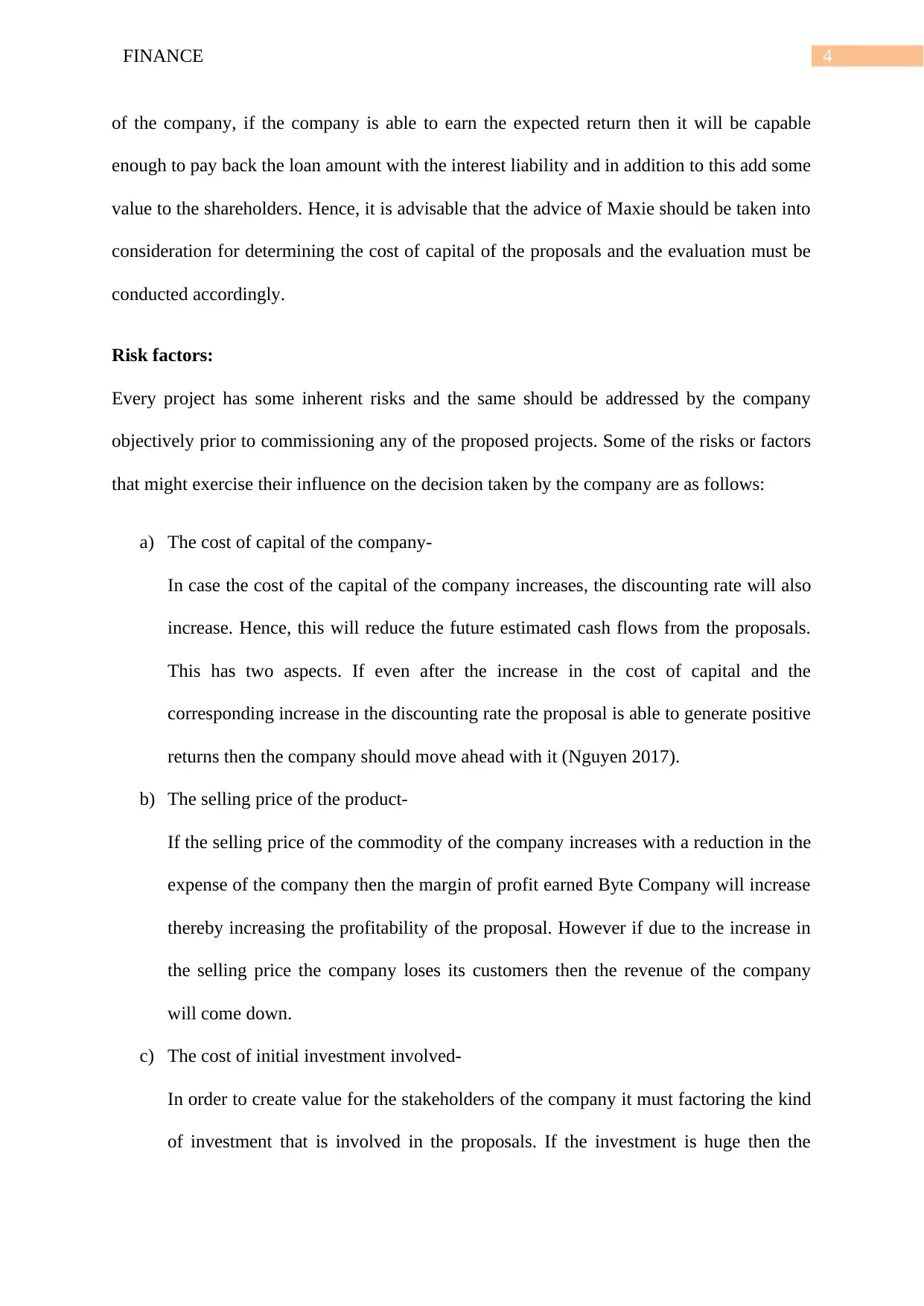
4FINANCE
of the company, if the company is able to earn the expected return then it will be capable
enough to pay back the loan amount with the interest liability and in addition to this add some
value to the shareholders. Hence, it is advisable that the advice of Maxie should be taken into
consideration for determining the cost of capital of the proposals and the evaluation must be
conducted accordingly.
Risk factors:
Every project has some inherent risks and the same should be addressed by the company
objectively prior to commissioning any of the proposed projects. Some of the risks or factors
that might exercise their influence on the decision taken by the company are as follows:
a) The cost of capital of the company-
In case the cost of the capital of the company increases, the discounting rate will also
increase. Hence, this will reduce the future estimated cash flows from the proposals.
This has two aspects. If even after the increase in the cost of capital and the
corresponding increase in the discounting rate the proposal is able to generate positive
returns then the company should move ahead with it (Nguyen 2017).
b) The selling price of the product-
If the selling price of the commodity of the company increases with a reduction in the
expense of the company then the margin of profit earned Byte Company will increase
thereby increasing the profitability of the proposal. However if due to the increase in
the selling price the company loses its customers then the revenue of the company
will come down.
c) The cost of initial investment involved-
In order to create value for the stakeholders of the company it must factoring the kind
of investment that is involved in the proposals. If the investment is huge then the
of the company, if the company is able to earn the expected return then it will be capable
enough to pay back the loan amount with the interest liability and in addition to this add some
value to the shareholders. Hence, it is advisable that the advice of Maxie should be taken into
consideration for determining the cost of capital of the proposals and the evaluation must be
conducted accordingly.
Risk factors:
Every project has some inherent risks and the same should be addressed by the company
objectively prior to commissioning any of the proposed projects. Some of the risks or factors
that might exercise their influence on the decision taken by the company are as follows:
a) The cost of capital of the company-
In case the cost of the capital of the company increases, the discounting rate will also
increase. Hence, this will reduce the future estimated cash flows from the proposals.
This has two aspects. If even after the increase in the cost of capital and the
corresponding increase in the discounting rate the proposal is able to generate positive
returns then the company should move ahead with it (Nguyen 2017).
b) The selling price of the product-
If the selling price of the commodity of the company increases with a reduction in the
expense of the company then the margin of profit earned Byte Company will increase
thereby increasing the profitability of the proposal. However if due to the increase in
the selling price the company loses its customers then the revenue of the company
will come down.
c) The cost of initial investment involved-
In order to create value for the stakeholders of the company it must factoring the kind
of investment that is involved in the proposals. If the investment is huge then the
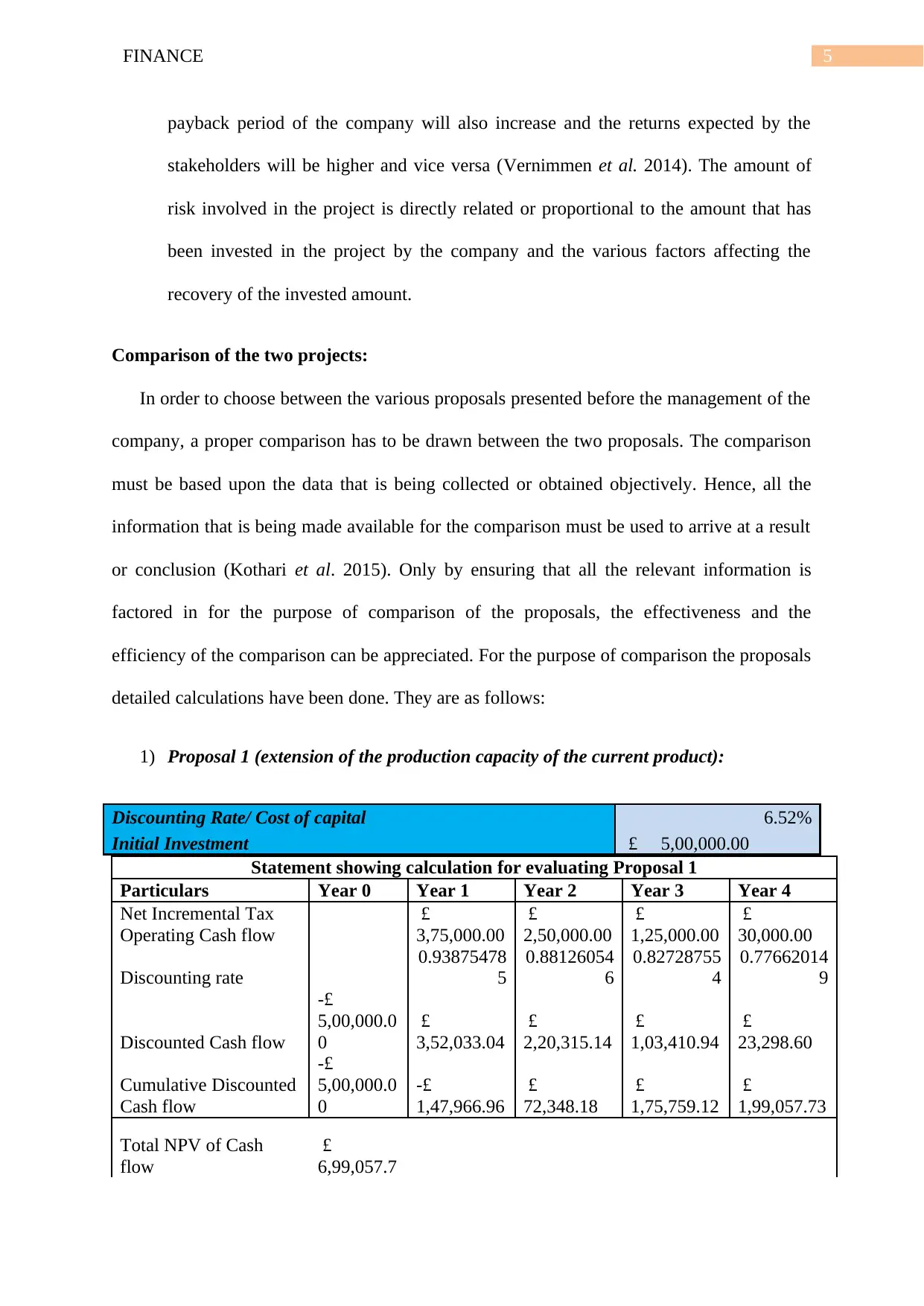
5FINANCE
payback period of the company will also increase and the returns expected by the
stakeholders will be higher and vice versa (Vernimmen et al. 2014). The amount of
risk involved in the project is directly related or proportional to the amount that has
been invested in the project by the company and the various factors affecting the
recovery of the invested amount.
Comparison of the two projects:
In order to choose between the various proposals presented before the management of the
company, a proper comparison has to be drawn between the two proposals. The comparison
must be based upon the data that is being collected or obtained objectively. Hence, all the
information that is being made available for the comparison must be used to arrive at a result
or conclusion (Kothari et al. 2015). Only by ensuring that all the relevant information is
factored in for the purpose of comparison of the proposals, the effectiveness and the
efficiency of the comparison can be appreciated. For the purpose of comparison the proposals
detailed calculations have been done. They are as follows:
1) Proposal 1 (extension of the production capacity of the current product):
Discounting Rate/ Cost of capital 6.52%
Initial Investment £ 5,00,000.00
Statement showing calculation for evaluating Proposal 1
Particulars Year 0 Year 1 Year 2 Year 3 Year 4
Net Incremental Tax
Operating Cash flow
£
3,75,000.00
£
2,50,000.00
£
1,25,000.00
£
30,000.00
Discounting rate
0.93875478
5
0.88126054
6
0.82728755
4
0.77662014
9
Discounted Cash flow
-£
5,00,000.0
0
£
3,52,033.04
£
2,20,315.14
£
1,03,410.94
£
23,298.60
Cumulative Discounted
Cash flow
-£
5,00,000.0
0
-£
1,47,966.96
£
72,348.18
£
1,75,759.12
£
1,99,057.73
Total NPV of Cash
flow
£
6,99,057.7
payback period of the company will also increase and the returns expected by the
stakeholders will be higher and vice versa (Vernimmen et al. 2014). The amount of
risk involved in the project is directly related or proportional to the amount that has
been invested in the project by the company and the various factors affecting the
recovery of the invested amount.
Comparison of the two projects:
In order to choose between the various proposals presented before the management of the
company, a proper comparison has to be drawn between the two proposals. The comparison
must be based upon the data that is being collected or obtained objectively. Hence, all the
information that is being made available for the comparison must be used to arrive at a result
or conclusion (Kothari et al. 2015). Only by ensuring that all the relevant information is
factored in for the purpose of comparison of the proposals, the effectiveness and the
efficiency of the comparison can be appreciated. For the purpose of comparison the proposals
detailed calculations have been done. They are as follows:
1) Proposal 1 (extension of the production capacity of the current product):
Discounting Rate/ Cost of capital 6.52%
Initial Investment £ 5,00,000.00
Statement showing calculation for evaluating Proposal 1
Particulars Year 0 Year 1 Year 2 Year 3 Year 4
Net Incremental Tax
Operating Cash flow
£
3,75,000.00
£
2,50,000.00
£
1,25,000.00
£
30,000.00
Discounting rate
0.93875478
5
0.88126054
6
0.82728755
4
0.77662014
9
Discounted Cash flow
-£
5,00,000.0
0
£
3,52,033.04
£
2,20,315.14
£
1,03,410.94
£
23,298.60
Cumulative Discounted
Cash flow
-£
5,00,000.0
0
-£
1,47,966.96
£
72,348.18
£
1,75,759.12
£
1,99,057.73
Total NPV of Cash
flow
£
6,99,057.7
⊘ This is a preview!⊘
Do you want full access?
Subscribe today to unlock all pages.

Trusted by 1+ million students worldwide
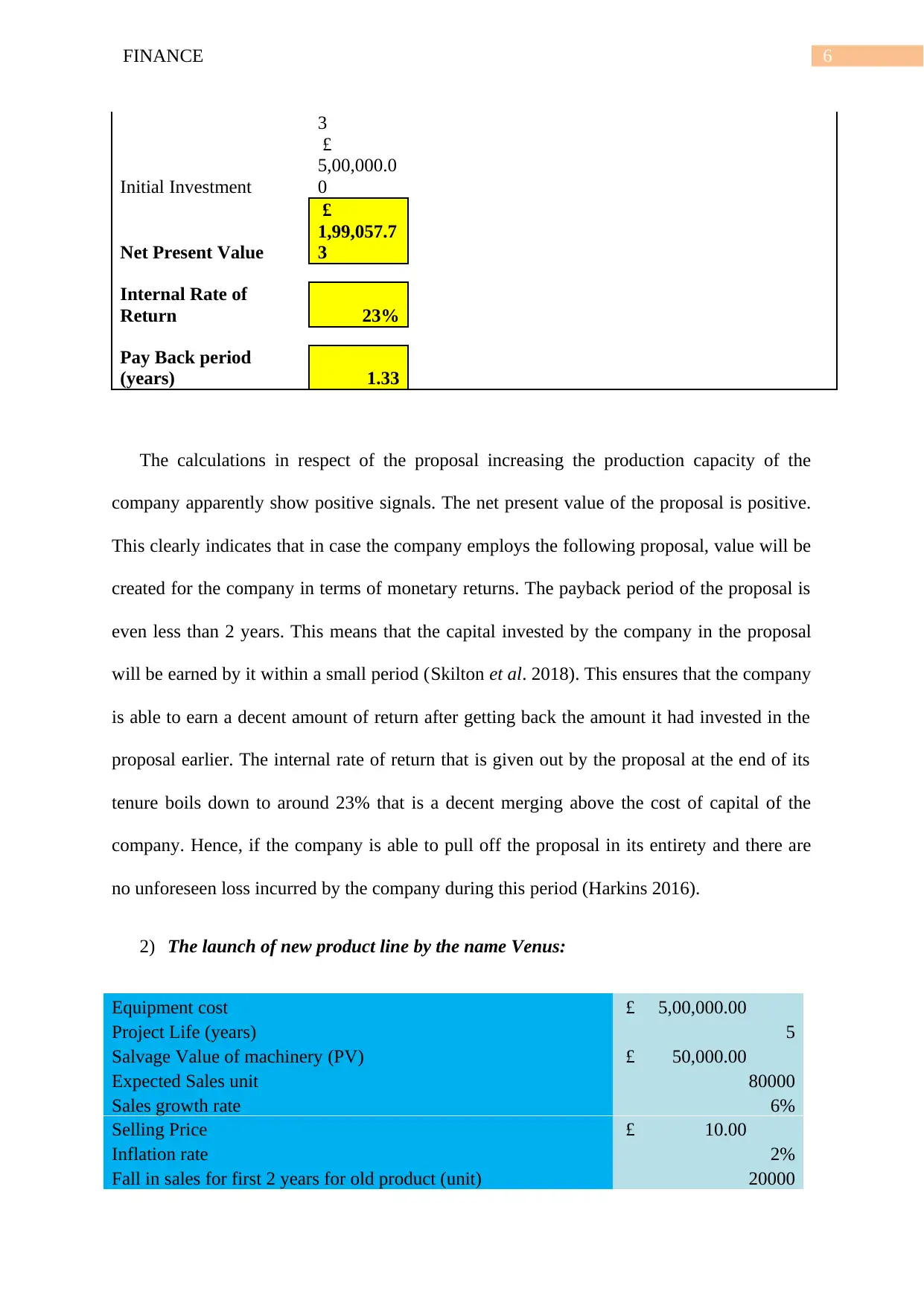
6FINANCE
3
Initial Investment
£
5,00,000.0
0
Net Present Value
£
1,99,057.7
3
Internal Rate of
Return 23%
Pay Back period
(years) 1.33
The calculations in respect of the proposal increasing the production capacity of the
company apparently show positive signals. The net present value of the proposal is positive.
This clearly indicates that in case the company employs the following proposal, value will be
created for the company in terms of monetary returns. The payback period of the proposal is
even less than 2 years. This means that the capital invested by the company in the proposal
will be earned by it within a small period (Skilton et al. 2018). This ensures that the company
is able to earn a decent amount of return after getting back the amount it had invested in the
proposal earlier. The internal rate of return that is given out by the proposal at the end of its
tenure boils down to around 23% that is a decent merging above the cost of capital of the
company. Hence, if the company is able to pull off the proposal in its entirety and there are
no unforeseen loss incurred by the company during this period (Harkins 2016).
2) The launch of new product line by the name Venus:
Equipment cost £ 5,00,000.00
Project Life (years) 5
Salvage Value of machinery (PV) £ 50,000.00
Expected Sales unit 80000
Sales growth rate 6%
Selling Price £ 10.00
Inflation rate 2%
Fall in sales for first 2 years for old product (unit) 20000
3
Initial Investment
£
5,00,000.0
0
Net Present Value
£
1,99,057.7
3
Internal Rate of
Return 23%
Pay Back period
(years) 1.33
The calculations in respect of the proposal increasing the production capacity of the
company apparently show positive signals. The net present value of the proposal is positive.
This clearly indicates that in case the company employs the following proposal, value will be
created for the company in terms of monetary returns. The payback period of the proposal is
even less than 2 years. This means that the capital invested by the company in the proposal
will be earned by it within a small period (Skilton et al. 2018). This ensures that the company
is able to earn a decent amount of return after getting back the amount it had invested in the
proposal earlier. The internal rate of return that is given out by the proposal at the end of its
tenure boils down to around 23% that is a decent merging above the cost of capital of the
company. Hence, if the company is able to pull off the proposal in its entirety and there are
no unforeseen loss incurred by the company during this period (Harkins 2016).
2) The launch of new product line by the name Venus:
Equipment cost £ 5,00,000.00
Project Life (years) 5
Salvage Value of machinery (PV) £ 50,000.00
Expected Sales unit 80000
Sales growth rate 6%
Selling Price £ 10.00
Inflation rate 2%
Fall in sales for first 2 years for old product (unit) 20000
Paraphrase This Document
Need a fresh take? Get an instant paraphrase of this document with our AI Paraphraser
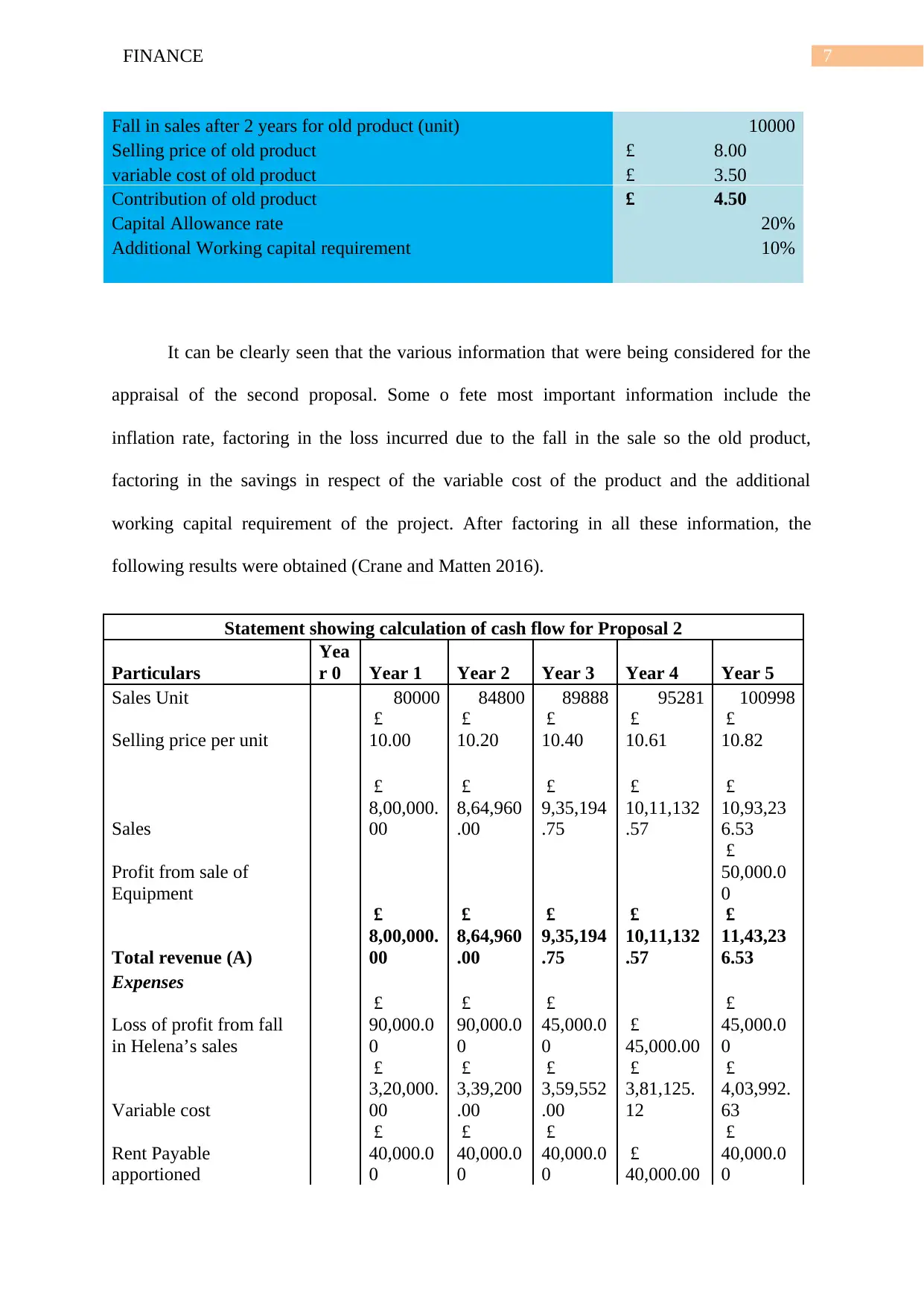
7FINANCE
Fall in sales after 2 years for old product (unit) 10000
Selling price of old product £ 8.00
variable cost of old product £ 3.50
Contribution of old product £ 4.50
Capital Allowance rate 20%
Additional Working capital requirement 10%
It can be clearly seen that the various information that were being considered for the
appraisal of the second proposal. Some o fete most important information include the
inflation rate, factoring in the loss incurred due to the fall in the sale so the old product,
factoring in the savings in respect of the variable cost of the product and the additional
working capital requirement of the project. After factoring in all these information, the
following results were obtained (Crane and Matten 2016).
Statement showing calculation of cash flow for Proposal 2
Particulars
Yea
r 0 Year 1 Year 2 Year 3 Year 4 Year 5
Sales Unit 80000 84800 89888 95281 100998
Selling price per unit
£
10.00
£
10.20
£
10.40
£
10.61
£
10.82
Sales
£
8,00,000.
00
£
8,64,960
.00
£
9,35,194
.75
£
10,11,132
.57
£
10,93,23
6.53
Profit from sale of
Equipment
£
50,000.0
0
Total revenue (A)
£
8,00,000.
00
£
8,64,960
.00
£
9,35,194
.75
£
10,11,132
.57
£
11,43,23
6.53
Expenses
Loss of profit from fall
in Helena’s sales
£
90,000.0
0
£
90,000.0
0
£
45,000.0
0
£
45,000.00
£
45,000.0
0
Variable cost
£
3,20,000.
00
£
3,39,200
.00
£
3,59,552
.00
£
3,81,125.
12
£
4,03,992.
63
Rent Payable
apportioned
£
40,000.0
0
£
40,000.0
0
£
40,000.0
0
£
40,000.00
£
40,000.0
0
Fall in sales after 2 years for old product (unit) 10000
Selling price of old product £ 8.00
variable cost of old product £ 3.50
Contribution of old product £ 4.50
Capital Allowance rate 20%
Additional Working capital requirement 10%
It can be clearly seen that the various information that were being considered for the
appraisal of the second proposal. Some o fete most important information include the
inflation rate, factoring in the loss incurred due to the fall in the sale so the old product,
factoring in the savings in respect of the variable cost of the product and the additional
working capital requirement of the project. After factoring in all these information, the
following results were obtained (Crane and Matten 2016).
Statement showing calculation of cash flow for Proposal 2
Particulars
Yea
r 0 Year 1 Year 2 Year 3 Year 4 Year 5
Sales Unit 80000 84800 89888 95281 100998
Selling price per unit
£
10.00
£
10.20
£
10.40
£
10.61
£
10.82
Sales
£
8,00,000.
00
£
8,64,960
.00
£
9,35,194
.75
£
10,11,132
.57
£
10,93,23
6.53
Profit from sale of
Equipment
£
50,000.0
0
Total revenue (A)
£
8,00,000.
00
£
8,64,960
.00
£
9,35,194
.75
£
10,11,132
.57
£
11,43,23
6.53
Expenses
Loss of profit from fall
in Helena’s sales
£
90,000.0
0
£
90,000.0
0
£
45,000.0
0
£
45,000.00
£
45,000.0
0
Variable cost
£
3,20,000.
00
£
3,39,200
.00
£
3,59,552
.00
£
3,81,125.
12
£
4,03,992.
63
Rent Payable
apportioned
£
40,000.0
0
£
40,000.0
0
£
40,000.0
0
£
40,000.00
£
40,000.0
0
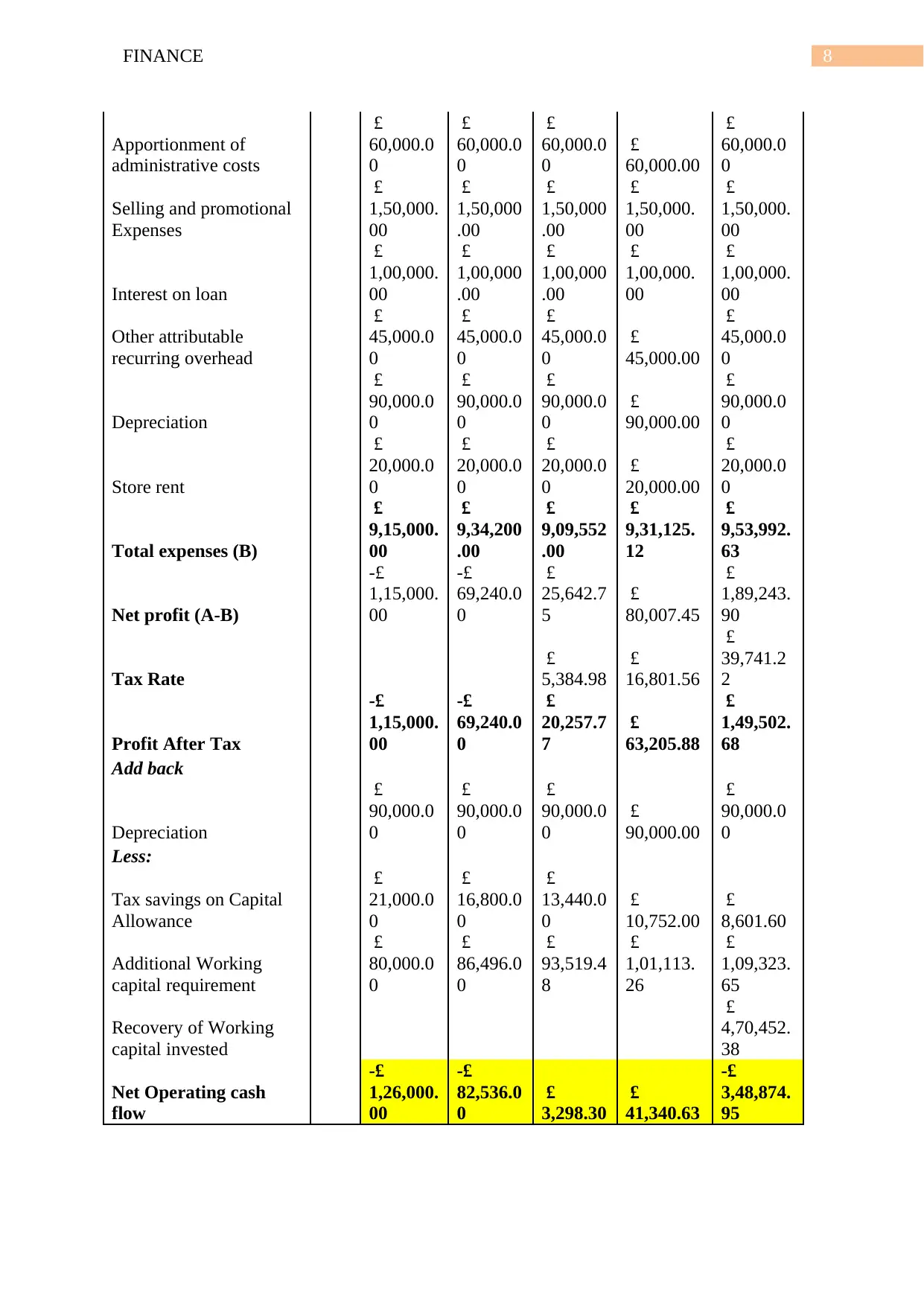
8FINANCE
Apportionment of
administrative costs
£
60,000.0
0
£
60,000.0
0
£
60,000.0
0
£
60,000.00
£
60,000.0
0
Selling and promotional
Expenses
£
1,50,000.
00
£
1,50,000
.00
£
1,50,000
.00
£
1,50,000.
00
£
1,50,000.
00
Interest on loan
£
1,00,000.
00
£
1,00,000
.00
£
1,00,000
.00
£
1,00,000.
00
£
1,00,000.
00
Other attributable
recurring overhead
£
45,000.0
0
£
45,000.0
0
£
45,000.0
0
£
45,000.00
£
45,000.0
0
Depreciation
£
90,000.0
0
£
90,000.0
0
£
90,000.0
0
£
90,000.00
£
90,000.0
0
Store rent
£
20,000.0
0
£
20,000.0
0
£
20,000.0
0
£
20,000.00
£
20,000.0
0
Total expenses (B)
£
9,15,000.
00
£
9,34,200
.00
£
9,09,552
.00
£
9,31,125.
12
£
9,53,992.
63
Net profit (A-B)
-£
1,15,000.
00
-£
69,240.0
0
£
25,642.7
5
£
80,007.45
£
1,89,243.
90
Tax Rate
£
5,384.98
£
16,801.56
£
39,741.2
2
Profit After Tax
-£
1,15,000.
00
-£
69,240.0
0
£
20,257.7
7
£
63,205.88
£
1,49,502.
68
Add back
Depreciation
£
90,000.0
0
£
90,000.0
0
£
90,000.0
0
£
90,000.00
£
90,000.0
0
Less:
Tax savings on Capital
Allowance
£
21,000.0
0
£
16,800.0
0
£
13,440.0
0
£
10,752.00
£
8,601.60
Additional Working
capital requirement
£
80,000.0
0
£
86,496.0
0
£
93,519.4
8
£
1,01,113.
26
£
1,09,323.
65
Recovery of Working
capital invested
£
4,70,452.
38
Net Operating cash
flow
-£
1,26,000.
00
-£
82,536.0
0
£
3,298.30
£
41,340.63
-£
3,48,874.
95
Apportionment of
administrative costs
£
60,000.0
0
£
60,000.0
0
£
60,000.0
0
£
60,000.00
£
60,000.0
0
Selling and promotional
Expenses
£
1,50,000.
00
£
1,50,000
.00
£
1,50,000
.00
£
1,50,000.
00
£
1,50,000.
00
Interest on loan
£
1,00,000.
00
£
1,00,000
.00
£
1,00,000
.00
£
1,00,000.
00
£
1,00,000.
00
Other attributable
recurring overhead
£
45,000.0
0
£
45,000.0
0
£
45,000.0
0
£
45,000.00
£
45,000.0
0
Depreciation
£
90,000.0
0
£
90,000.0
0
£
90,000.0
0
£
90,000.00
£
90,000.0
0
Store rent
£
20,000.0
0
£
20,000.0
0
£
20,000.0
0
£
20,000.00
£
20,000.0
0
Total expenses (B)
£
9,15,000.
00
£
9,34,200
.00
£
9,09,552
.00
£
9,31,125.
12
£
9,53,992.
63
Net profit (A-B)
-£
1,15,000.
00
-£
69,240.0
0
£
25,642.7
5
£
80,007.45
£
1,89,243.
90
Tax Rate
£
5,384.98
£
16,801.56
£
39,741.2
2
Profit After Tax
-£
1,15,000.
00
-£
69,240.0
0
£
20,257.7
7
£
63,205.88
£
1,49,502.
68
Add back
Depreciation
£
90,000.0
0
£
90,000.0
0
£
90,000.0
0
£
90,000.00
£
90,000.0
0
Less:
Tax savings on Capital
Allowance
£
21,000.0
0
£
16,800.0
0
£
13,440.0
0
£
10,752.00
£
8,601.60
Additional Working
capital requirement
£
80,000.0
0
£
86,496.0
0
£
93,519.4
8
£
1,01,113.
26
£
1,09,323.
65
Recovery of Working
capital invested
£
4,70,452.
38
Net Operating cash
flow
-£
1,26,000.
00
-£
82,536.0
0
£
3,298.30
£
41,340.63
-£
3,48,874.
95
⊘ This is a preview!⊘
Do you want full access?
Subscribe today to unlock all pages.

Trusted by 1+ million students worldwide
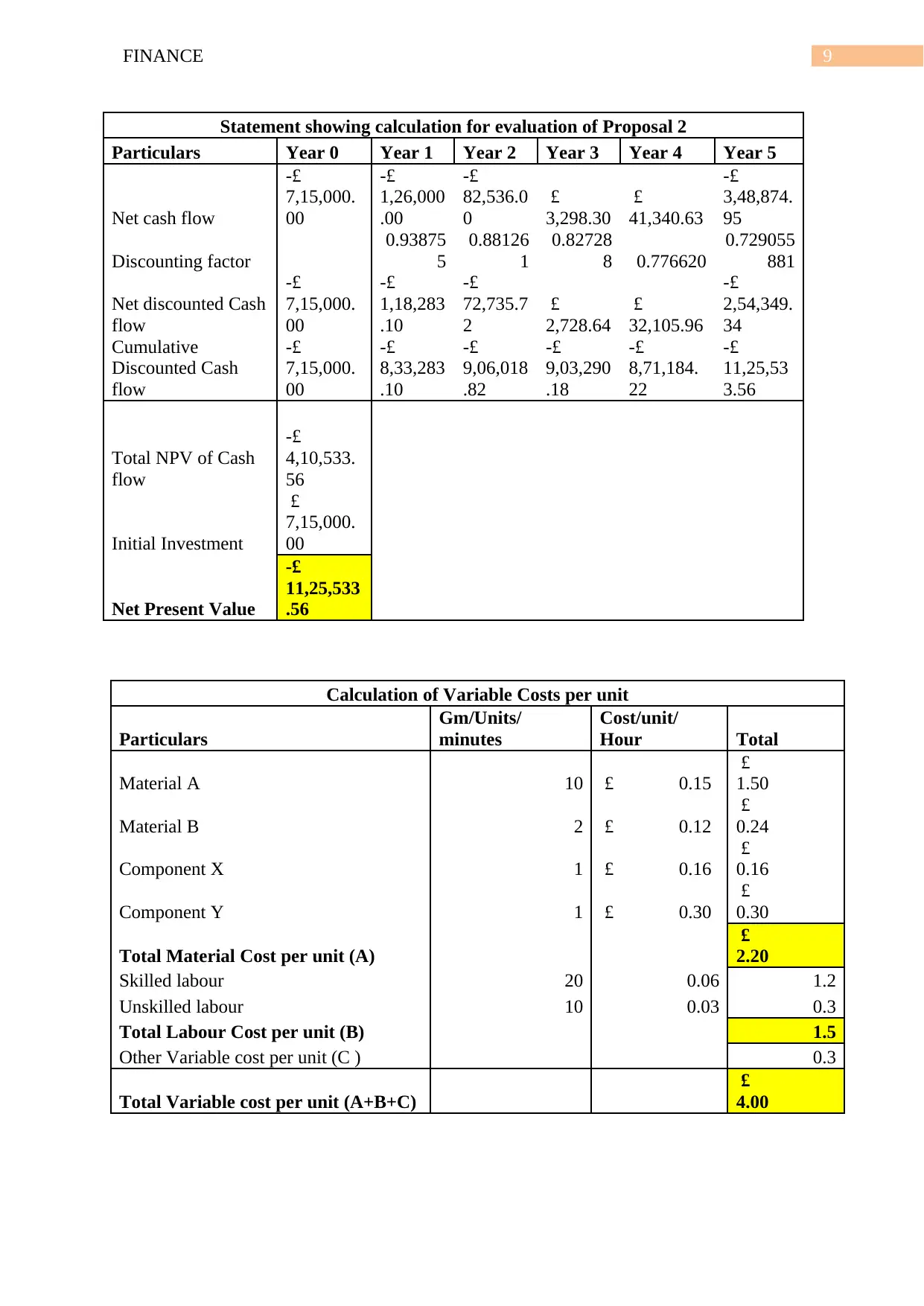
9FINANCE
Statement showing calculation for evaluation of Proposal 2
Particulars Year 0 Year 1 Year 2 Year 3 Year 4 Year 5
Net cash flow
-£
7,15,000.
00
-£
1,26,000
.00
-£
82,536.0
0
£
3,298.30
£
41,340.63
-£
3,48,874.
95
Discounting factor
0.93875
5
0.88126
1
0.82728
8 0.776620
0.729055
881
Net discounted Cash
flow
-£
7,15,000.
00
-£
1,18,283
.10
-£
72,735.7
2
£
2,728.64
£
32,105.96
-£
2,54,349.
34
Cumulative
Discounted Cash
flow
-£
7,15,000.
00
-£
8,33,283
.10
-£
9,06,018
.82
-£
9,03,290
.18
-£
8,71,184.
22
-£
11,25,53
3.56
Total NPV of Cash
flow
-£
4,10,533.
56
Initial Investment
£
7,15,000.
00
Net Present Value
-£
11,25,533
.56
Calculation of Variable Costs per unit
Particulars
Gm/Units/
minutes
Cost/unit/
Hour Total
Material A 10 £ 0.15
£
1.50
Material B 2 £ 0.12
£
0.24
Component X 1 £ 0.16
£
0.16
Component Y 1 £ 0.30
£
0.30
Total Material Cost per unit (A)
£
2.20
Skilled labour 20 0.06 1.2
Unskilled labour 10 0.03 0.3
Total Labour Cost per unit (B) 1.5
Other Variable cost per unit (C ) 0.3
Total Variable cost per unit (A+B+C)
£
4.00
Statement showing calculation for evaluation of Proposal 2
Particulars Year 0 Year 1 Year 2 Year 3 Year 4 Year 5
Net cash flow
-£
7,15,000.
00
-£
1,26,000
.00
-£
82,536.0
0
£
3,298.30
£
41,340.63
-£
3,48,874.
95
Discounting factor
0.93875
5
0.88126
1
0.82728
8 0.776620
0.729055
881
Net discounted Cash
flow
-£
7,15,000.
00
-£
1,18,283
.10
-£
72,735.7
2
£
2,728.64
£
32,105.96
-£
2,54,349.
34
Cumulative
Discounted Cash
flow
-£
7,15,000.
00
-£
8,33,283
.10
-£
9,06,018
.82
-£
9,03,290
.18
-£
8,71,184.
22
-£
11,25,53
3.56
Total NPV of Cash
flow
-£
4,10,533.
56
Initial Investment
£
7,15,000.
00
Net Present Value
-£
11,25,533
.56
Calculation of Variable Costs per unit
Particulars
Gm/Units/
minutes
Cost/unit/
Hour Total
Material A 10 £ 0.15
£
1.50
Material B 2 £ 0.12
£
0.24
Component X 1 £ 0.16
£
0.16
Component Y 1 £ 0.30
£
0.30
Total Material Cost per unit (A)
£
2.20
Skilled labour 20 0.06 1.2
Unskilled labour 10 0.03 0.3
Total Labour Cost per unit (B) 1.5
Other Variable cost per unit (C ) 0.3
Total Variable cost per unit (A+B+C)
£
4.00
Paraphrase This Document
Need a fresh take? Get an instant paraphrase of this document with our AI Paraphraser
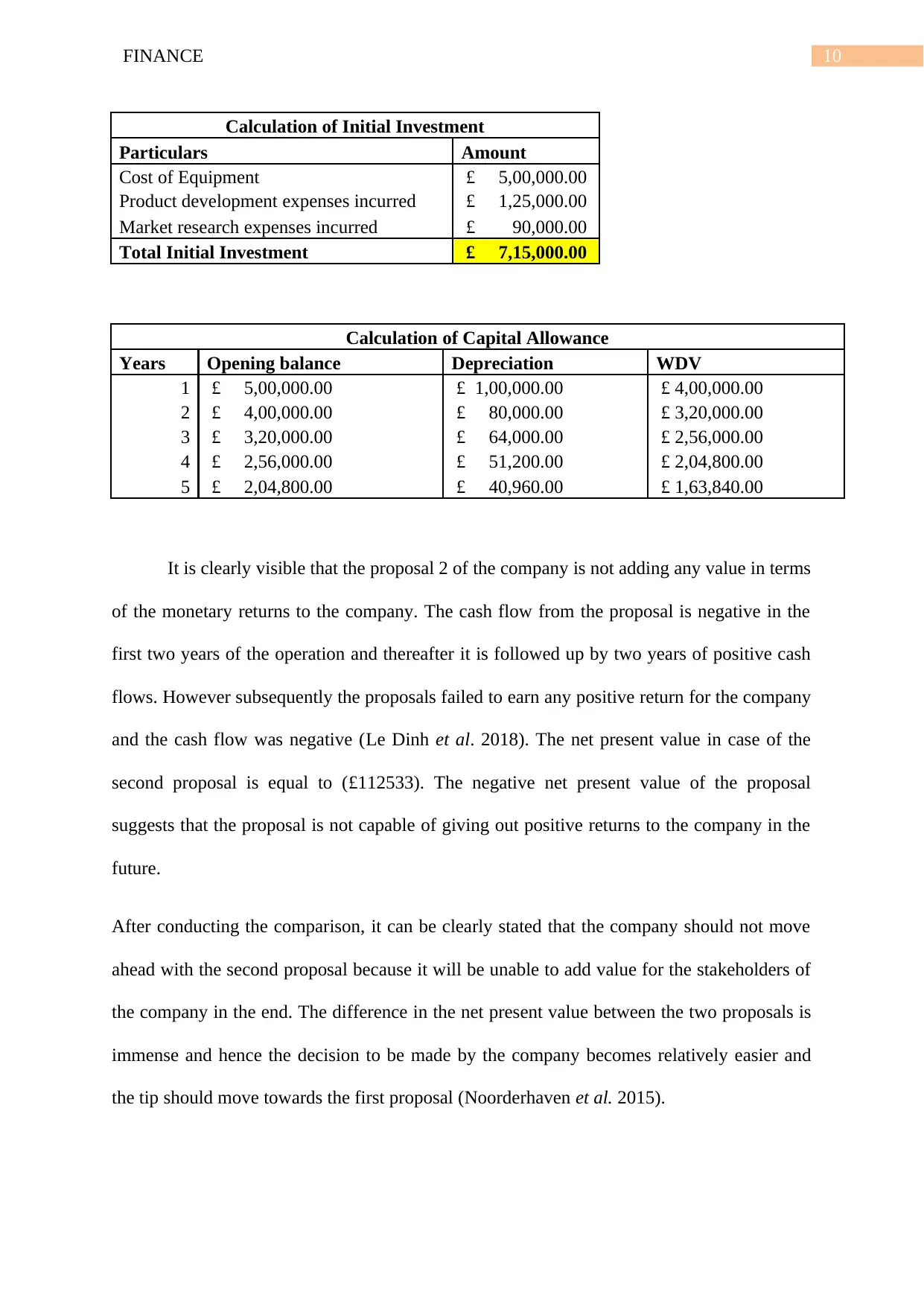
10FINANCE
Calculation of Initial Investment
Particulars Amount
Cost of Equipment £ 5,00,000.00
Product development expenses incurred £ 1,25,000.00
Market research expenses incurred £ 90,000.00
Total Initial Investment £ 7,15,000.00
Calculation of Capital Allowance
Years Opening balance Depreciation WDV
1 £ 5,00,000.00 £ 1,00,000.00 £ 4,00,000.00
2 £ 4,00,000.00 £ 80,000.00 £ 3,20,000.00
3 £ 3,20,000.00 £ 64,000.00 £ 2,56,000.00
4 £ 2,56,000.00 £ 51,200.00 £ 2,04,800.00
5 £ 2,04,800.00 £ 40,960.00 £ 1,63,840.00
It is clearly visible that the proposal 2 of the company is not adding any value in terms
of the monetary returns to the company. The cash flow from the proposal is negative in the
first two years of the operation and thereafter it is followed up by two years of positive cash
flows. However subsequently the proposals failed to earn any positive return for the company
and the cash flow was negative (Le Dinh et al. 2018). The net present value in case of the
second proposal is equal to (£112533). The negative net present value of the proposal
suggests that the proposal is not capable of giving out positive returns to the company in the
future.
After conducting the comparison, it can be clearly stated that the company should not move
ahead with the second proposal because it will be unable to add value for the stakeholders of
the company in the end. The difference in the net present value between the two proposals is
immense and hence the decision to be made by the company becomes relatively easier and
the tip should move towards the first proposal (Noorderhaven et al. 2015).
Calculation of Initial Investment
Particulars Amount
Cost of Equipment £ 5,00,000.00
Product development expenses incurred £ 1,25,000.00
Market research expenses incurred £ 90,000.00
Total Initial Investment £ 7,15,000.00
Calculation of Capital Allowance
Years Opening balance Depreciation WDV
1 £ 5,00,000.00 £ 1,00,000.00 £ 4,00,000.00
2 £ 4,00,000.00 £ 80,000.00 £ 3,20,000.00
3 £ 3,20,000.00 £ 64,000.00 £ 2,56,000.00
4 £ 2,56,000.00 £ 51,200.00 £ 2,04,800.00
5 £ 2,04,800.00 £ 40,960.00 £ 1,63,840.00
It is clearly visible that the proposal 2 of the company is not adding any value in terms
of the monetary returns to the company. The cash flow from the proposal is negative in the
first two years of the operation and thereafter it is followed up by two years of positive cash
flows. However subsequently the proposals failed to earn any positive return for the company
and the cash flow was negative (Le Dinh et al. 2018). The net present value in case of the
second proposal is equal to (£112533). The negative net present value of the proposal
suggests that the proposal is not capable of giving out positive returns to the company in the
future.
After conducting the comparison, it can be clearly stated that the company should not move
ahead with the second proposal because it will be unable to add value for the stakeholders of
the company in the end. The difference in the net present value between the two proposals is
immense and hence the decision to be made by the company becomes relatively easier and
the tip should move towards the first proposal (Noorderhaven et al. 2015).
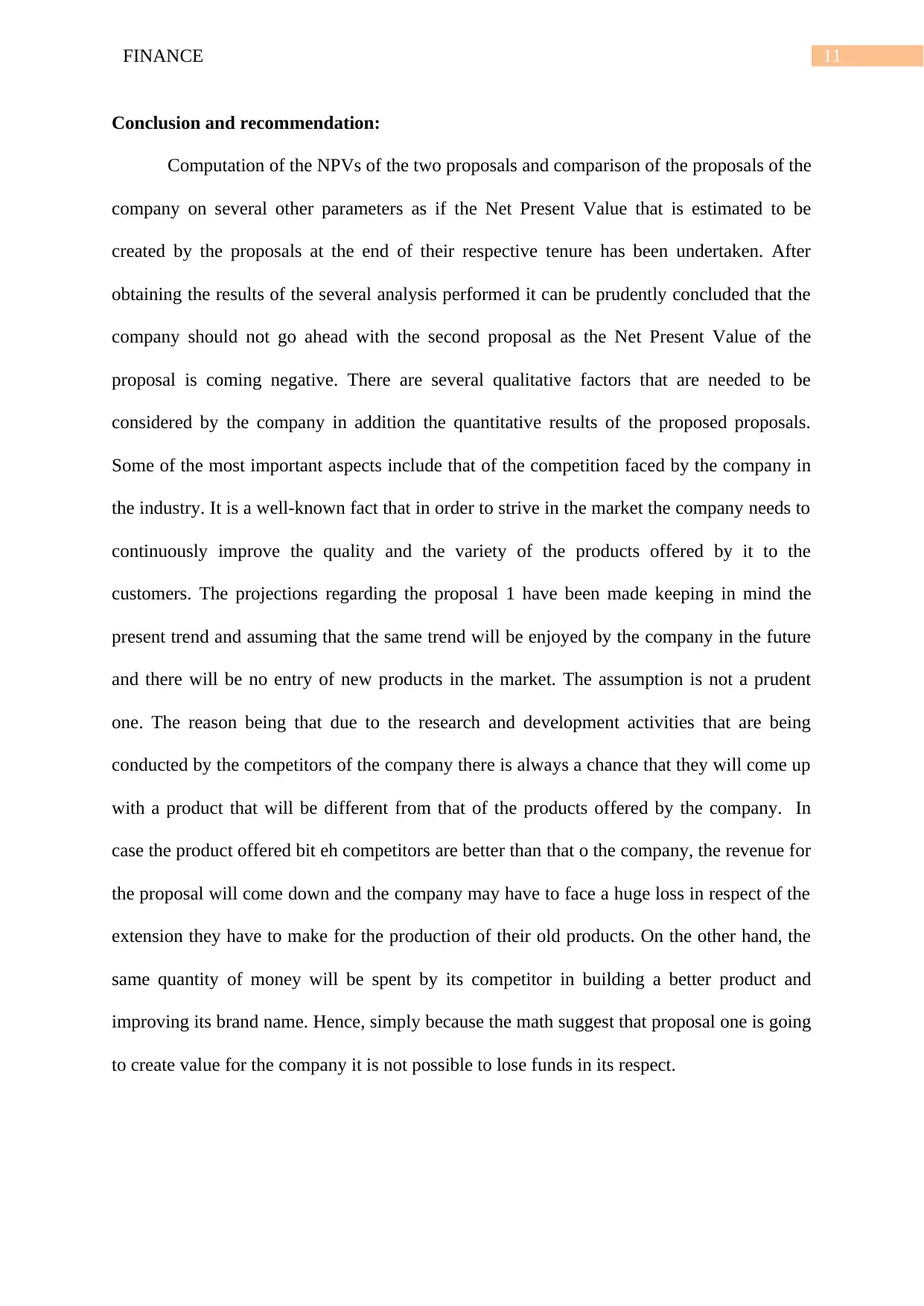
11FINANCE
Conclusion and recommendation:
Computation of the NPVs of the two proposals and comparison of the proposals of the
company on several other parameters as if the Net Present Value that is estimated to be
created by the proposals at the end of their respective tenure has been undertaken. After
obtaining the results of the several analysis performed it can be prudently concluded that the
company should not go ahead with the second proposal as the Net Present Value of the
proposal is coming negative. There are several qualitative factors that are needed to be
considered by the company in addition the quantitative results of the proposed proposals.
Some of the most important aspects include that of the competition faced by the company in
the industry. It is a well-known fact that in order to strive in the market the company needs to
continuously improve the quality and the variety of the products offered by it to the
customers. The projections regarding the proposal 1 have been made keeping in mind the
present trend and assuming that the same trend will be enjoyed by the company in the future
and there will be no entry of new products in the market. The assumption is not a prudent
one. The reason being that due to the research and development activities that are being
conducted by the competitors of the company there is always a chance that they will come up
with a product that will be different from that of the products offered by the company. In
case the product offered bit eh competitors are better than that o the company, the revenue for
the proposal will come down and the company may have to face a huge loss in respect of the
extension they have to make for the production of their old products. On the other hand, the
same quantity of money will be spent by its competitor in building a better product and
improving its brand name. Hence, simply because the math suggest that proposal one is going
to create value for the company it is not possible to lose funds in its respect.
Conclusion and recommendation:
Computation of the NPVs of the two proposals and comparison of the proposals of the
company on several other parameters as if the Net Present Value that is estimated to be
created by the proposals at the end of their respective tenure has been undertaken. After
obtaining the results of the several analysis performed it can be prudently concluded that the
company should not go ahead with the second proposal as the Net Present Value of the
proposal is coming negative. There are several qualitative factors that are needed to be
considered by the company in addition the quantitative results of the proposed proposals.
Some of the most important aspects include that of the competition faced by the company in
the industry. It is a well-known fact that in order to strive in the market the company needs to
continuously improve the quality and the variety of the products offered by it to the
customers. The projections regarding the proposal 1 have been made keeping in mind the
present trend and assuming that the same trend will be enjoyed by the company in the future
and there will be no entry of new products in the market. The assumption is not a prudent
one. The reason being that due to the research and development activities that are being
conducted by the competitors of the company there is always a chance that they will come up
with a product that will be different from that of the products offered by the company. In
case the product offered bit eh competitors are better than that o the company, the revenue for
the proposal will come down and the company may have to face a huge loss in respect of the
extension they have to make for the production of their old products. On the other hand, the
same quantity of money will be spent by its competitor in building a better product and
improving its brand name. Hence, simply because the math suggest that proposal one is going
to create value for the company it is not possible to lose funds in its respect.
⊘ This is a preview!⊘
Do you want full access?
Subscribe today to unlock all pages.

Trusted by 1+ million students worldwide
1 out of 15
Related Documents
Your All-in-One AI-Powered Toolkit for Academic Success.
+13062052269
info@desklib.com
Available 24*7 on WhatsApp / Email
![[object Object]](/_next/static/media/star-bottom.7253800d.svg)
Unlock your academic potential
Copyright © 2020–2025 A2Z Services. All Rights Reserved. Developed and managed by ZUCOL.




